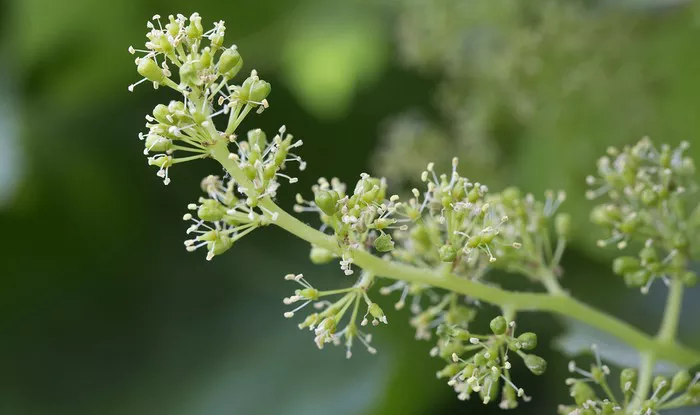Grapes, one of the oldest cultivated fruits known to humanity, owe their existence to the delicate and often overlooked beauty of grape flowers. These small, intricate blossoms play a crucial role in the grapevine’s reproductive cycle, ultimately leading to the creation of the beloved fruit and its derivatives, including wine, juice, and raisins. Understanding the anatomy, variations, significance, and cultivation of grape flowers unveils a fascinating world integral to viticulture and the enjoyment of one of nature’s finest gifts.
Anatomy of Grape Flowers
Grape flowers, like those of many fruit-bearing plants, possess both male and female reproductive organs. They typically appear in clusters known as inflorescences, with each individual flower comprising several key components:
1. Pedicel: The slender stalk that attaches the flower to the grapevine.
2. Sepals: Small, leaf-like structures that protect the developing flower bud.
3. Petals: Delicate, often colorful structures that surround the reproductive organs and attract pollinators.
4. Stamens: Male reproductive organs consisting of a filament and an anther. The anther produces pollen, the male gametes necessary for fertilization.
5. Pistil: The female reproductive organ, composed of the stigma, style, and ovary. The stigma captures pollen, which then travels down the style to fertilize the ovules within the ovary.
Variations in Grape Flowers
Grape flowers exhibit considerable variation across different grapevine species and cultivars. Some key variations include:
1. Color: While many grape flowers are white or cream-colored, some varieties boast vibrant hues of yellow, green, or even pink, adding to the visual appeal of the vineyard landscape.
2. Size and Shape: The size and shape of grape flowers can vary significantly, with some cultivars producing small, tightly clustered blooms, while others yield larger, more loosely arranged inflorescences.
3. Fragrance: Although grape flowers are not typically prized for their fragrance, some cultivars do emit subtle, pleasant scents that contribute to the overall sensory experience of the vineyard environment.
4. Fertility: Certain grape varieties may exhibit differences in fertility, affecting their ability to set fruit successfully. Factors such as temperature, humidity, and soil composition can influence fertility rates and ultimately impact grape yields.
Significance of Grape Flowers
Grape flowers hold immense significance within the realm of viticulture and winemaking, playing pivotal roles in the following areas:
1. Pollination: Grape flowers rely on pollination for fertilization and subsequent fruit set. While some grape varieties are self-pollinating, many require assistance from pollinators such as bees, butterflies, and birds to transfer pollen between flowers.
2. Fruit Development: Following successful pollination, grape flowers give rise to tiny, green fruit clusters that undergo a series of transformations before reaching maturity. The eventual development of grapes hinges upon the health and viability of the flowers during this critical stage.
3. Terroir Expression: The unique characteristics of grape flowers, including their aroma, color, and size, contribute to the concept of terroir—the idea that the environment in which grapes are grown imparts distinctive qualities to the resulting wine. Winemakers often seek to preserve and enhance these attributes to showcase the essence of a particular vineyard site.
4. Harvest Timing: Observing the stages of grape flower development is essential for determining the optimal timing of the grape harvest. Winemakers closely monitor flower clusters throughout the growing season, ensuring that grapes are harvested at the peak of ripeness to achieve desired flavor profiles and balance.
Cultivating Grape Flowers
Cultivating grape flowers involves careful attention to various factors that influence their growth and development. Key considerations include:
1. Site Selection: Choosing an appropriate site with adequate sunlight, soil drainage, and air circulation is crucial for promoting healthy grape flower formation. Factors such as elevation, slope orientation, and proximity to bodies of water can also impact flower development and overall vineyard productivity.
2. Pruning and Training: Proper pruning and training of grapevines help maintain an open canopy structure conducive to optimal flower exposure and airflow. Pruning practices vary depending on the grape variety, growth habits, and desired yield targets, with the goal of maximizing fruit quality while minimizing disease pressure.
3. Pest and Disease Management: Grape flowers are vulnerable to a range of pests and diseases that can jeopardize fruit production if left unchecked. Implementing integrated pest management strategies, including cultural, biological, and chemical controls, helps mitigate risks and ensure the health and vitality of grapevines throughout the growing season.
4. Fertilization and Irrigation: Providing adequate nutrition and water is essential for supporting vigorous grape flower development and subsequent fruit set. Soil testing and nutrient analysis guide fertilization practices, while efficient irrigation systems help maintain optimal moisture levels without promoting waterlogged conditions or excessive vine stress.
5. Weather Monitoring: Monitoring weather conditions, particularly during critical stages of flower development, is essential for mitigating risks associated with frost, heat stress, and inclement weather events. Employing protective measures such as frost blankets, wind machines, and irrigation can help safeguard grape flowers against adverse environmental conditions and minimize yield losses.
Conclusion
Grape flowers represent the delicate yet indispensable foundation upon which the world of viticulture and winemaking thrives. Their intricate anatomy, diverse variations, and profound significance underscore the artistry and science inherent in cultivating grapes and crafting fine wines. By understanding and appreciating the beauty and importance of grape flowers, growers and enthusiasts alike can deepen their connection to the timeless tradition of grape cultivation and the rich tapestry of flavors and aromas encapsulated in every bottle of wine.


